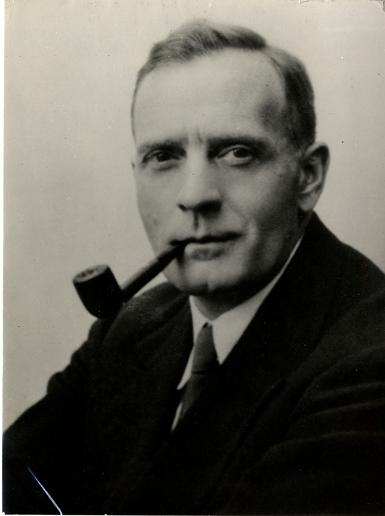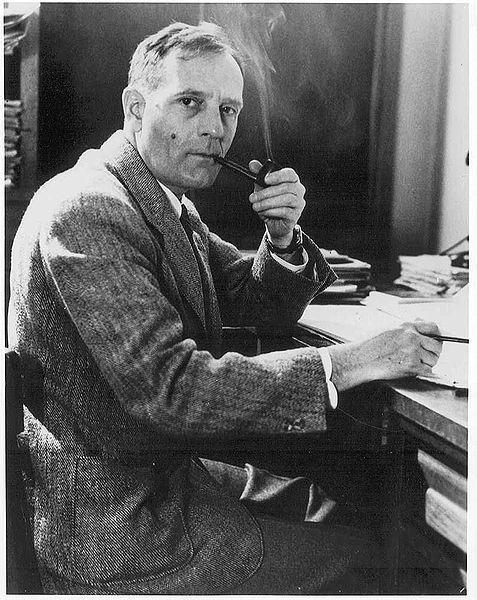<Back to Index>
- Astronomer Edwin Powell Hubble, 1889
- Painter Paulus Potter, 1625
- 7th Prime Minister of Canada Sir Wilfrid Laurier, 1841
PAGE SPONSOR


Edwin Powell Hubble (November 20, 1889 – September 28, 1953) was an American astronomer who profoundly changed our understanding of the universe by demonstrating the existence of galaxies other than our own, the Milky Way. He also discovered that the degree of "Doppler shift" (specifically "redshift") observed in the light spectra from other galaxies increased in proportion to a particular galaxy's distance from Earth. This relationship became known as Hubble's law, and helped establish that the known universe is expanding.
Hubble
is often incorrectly credited with discovering the Doppler shift in the
spectra of galaxies, but this phenomenon had been observed by other
astronomers in the 1910s, including Vesto Slipher at the Lowell Observatory. Slipher had reported observing blueshift as well as redshift in the spectra of spiral galaxies, indicating motion of their arms both toward and away from Earth respectively, and thus the rotation of such galaxies. Measurements of the redshifts of galaxies and analysis of their significance had also been conducted by James Keeler at the Lick and Allegheny observatories, and William Campbell at the Lick Observatory. Edwin Hubble was born to an insurance executive in Marshfield, Missouri, and moved to Wheaton, Illinois,
in 1898. In his younger days he was noted more for his athletic prowess
than his intellectual abilities, although he did earn good grades in
every subject except for spelling. He won seven first places and a
third place in a single high school track & field meet in 1906.
That year he also set the state high school record for the high jump in Illinois. Another of his personal interests was dry-fly fishing, and he practiced amateur boxing as well. His studies at the University of Chicago concentrated on mathematics, astronomy, and philosophy, which led to a bachelor of science in 1910. Hubble also became a member of the Kappa Sigma Fraternity (and in 1948 was named the Kappa Sigma "Man of the Year"). He spent the three years after earning his bachelors as one of Oxford University's first Rhodes Scholars, studying jurisprudence initally, then switching his major to Spanish and earning his master's degree in that field. Some of his acquired British mannerisms and dress stayed with him all his life, occasionally irritating his American colleagues. Upon returning to the United States, Hubble taught Spanish, physics, and mathematics at the New Albany High School in New Albany, Indiana. He also coached the boy's basketball team there. Hubble earned admission as a member of the Kentucky bar association, although he reportedly never actually practiced law in Kentucky. Hubble served in the U.S. Army in World War I, and he quickly advanced to the rank of major. He returned to astronomy at the Yerkes Observatory of the University of Chicago, where he received his Ph.D. in 1917. His dissertation was titled Photographic Investigations of Faint Nebulae. In 1919, Hubble was offered a staff position in California by George Ellery Hale, the founder and director of the Carnegie Institution's Mount Wilson Observatory, near Pasadena, California, where he remained on the staff until his death. Hubble also served in the U.S. Army at the Aberdeen Proving Ground during World War II. For his work there he received the Legion of Merit award. Shortly before his death, Mount Palomar's giant 200-inch (5.1 m) reflector Hale Telescope was
completed, and Hubble was the first astronomer to use it. Hubble
continued his research at the Mount Wilson and Mount Palomar
Observatories, where he remained active until his death. Hubble died of a cerebral thrombosis (a spontaneous blood clot in his brain) on September 28, 1953, in San Marino, California. No funeral was held for him, and his wife, Grace Hubble, did not reveal the disposition of his body. Edwin Hubble's arrival at Mount Wilson, California, in 1919 coincided roughly with the completion of the 100-inch (2.5 m) Hooker Telescope, then the world's largest telescope. At that time, the prevailing view
of the cosmos was that the universe consisted entirely of the Milky Way Galaxy. Using the Hooker Telescope at Mt. Wilson, Hubble identified Cepheid variables (a kind of star) in several spiral nebulae, including the Andromeda Nebula.
His observations, made in 1922 – 1923, proved conclusively that these
nebulae were much too distant to be part of the Milky Way and were, in
fact, entire galaxies outside our own. This idea had been opposed by
many in the astronomy establishment of the time, in particular by the Harvard University-based Harlow Shapley.
Hubble's discovery, announced on January 1, 1925, fundamentally changed
the view of the universe. Hubble also devised the most commonly used system for classifying galaxies, grouping them according to their appearance in photographic images. He arranged the different groups of galaxies in what became known as the Hubble sequence. Combining his own measurements of galaxy distances based on Henrietta Swan Leavitt's period-luminosity relationship for Cepheids with Vesto Slipher's measurements of the redshifts associated with the galaxies, Hubble and Milton L. Humason discovered
a rough proportionality of the objects' distances with their redshifts.
Though there was considerable scatter (now known to be due to peculiar
velocities), Hubble and Humason were able to plot a trend line from the
46 galaxies they studied and obtained a value for the Hubble-Humason
constant of 500 km/s/Mpc, which is much higher than the currently
accepted value due to errors in their distance calibrations. In 1929
Hubble and Humason formulated the empirical Redshift Distance Law of
galaxies, nowadays termed simply Hubble's law, which, if the redshift is interpreted as a measure of recession speed, is consistent with the solutions of Einstein’s equations of general relativity for a homogeneous, isotropic expanding space. Although concepts underlying an expanding universe were well understood earlier, this statement by Hubble and Humason led to
wider scale acceptance for this view. The law states that the greater
the distance between any two galaxies, the greater their relative speed
of separation. This discovery was the first observational support for the Big Bang theory which had been proposed by Georges Lemaître in 1927. The observed velocities of distant galaxies, taken together with the cosmological principle appeared to show that the Universe was expanding in a manner consistent with the Friedmann-Lemaître model of general relativity. In 1931 Hubble wrote a letter to the Dutch cosmologist Willem de Sitter expressing his opinion on the theoretical interpretation of the redshift-distance relation: Today, the 'apparent velocities' in question are understood as an increase in proper distance that occurs due to the expansion of space. Light traveling through stretching space will experience a Hubble-type redshift, a mechanism different from the Doppler effect (although the two mechanisms become equivalent descriptions related by a coordinate transformation for nearby galaxies). In the 1930s Hubble was involved in determining the distribution of galaxies and spatial curvature. These data seemed to indicate that the universe was flat and homogeneous, but there was a deviation from flatness at large redshifts. According to Allan Sandage, There
were methodological problems with Hubble's survey technique that showed
a deviation from flatness at large redshifts. In particular the
technique did not account for changes in luminosity of galaxies due to galaxy evolution. Earlier, in 1917, Albert Einstein had
found that his newly developed theory of general relativity indicated
that the universe must be either expanding or contracting. Unable to
believe what his own equations were telling him, Einstein introduced a cosmological constant (a "fudge factor")
to the equations to avoid this "problem". When Einstein heard of
Hubble's discovery, he said that changing his equations was "the
biggest blunder of [his] life".
Hubble discovered the asteroid 1373 Cincinnati on August 30, 1935. He also wrote The Observational Approach to Cosmology and The Realm of the Nebulae around this time. Hubble
spent much of the later part of his career attempting to have astronomy
considered an area of physics, instead of being its own science. He did
this largely so that astronomers — including himself — could
be recognized by the Nobel Prize Committee
for their valuable contributions to astrophysics. This campaign was
unsuccessful in Hubble's lifetime, but shortly after his death the
Nobel Prize Committee decided that astronomical work would be eligible
for the physics prize. On
March 6, 2008, the United States Postal Service released a 41 cent
stamp honoring Hubble on a sheet titled "American Scientists." His
citation reads: "Often called a 'pioneer of the distant stars,'
astronomer Edwin Hubble (1889 - 1953) played a pivotal role in
deciphering the vast and complex nature of the universe. His meticulous
studies of spiral nebulae proved the existence of galaxies other than
our own Milky Way. Had he not died suddenly in 1953, Hubble would have
won that year's Nobel Prize in Physics." The other scientists on the
"American Scientists" sheet include Gerty Cori, biochemist; Linus Pauling, chemist; and John Bardeen, physicist.